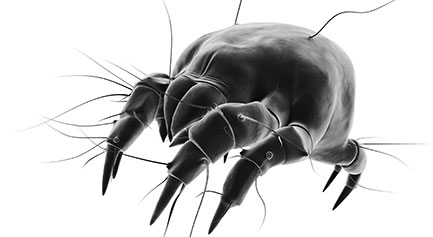Share
Related Topics
Tagged As
Dust mites and bed bugs are very different organisms and impact humans in very different ways. Dust mites are present in virtually every room of every home and building, bed bugs are not.
We do not strictly control Google ad content. If you believe any Google ad is inappropriate, please email us directly here.

House dust mites are microscopic bugs that primarily live on dead skin cells regularly shed from humans and their animal pets. They don't carry diseases, but they can cause allergic reactions in asthmatics and others who are allergic to their feces. A single dust mite produces about 20 waste droppings each day, each containing a protein to which many people are allergic. The proteins in that combination of feces and shed skin are what cause allergic reactions in humans. Depending on the person and exposure, reactions can range from itchy eyes to asthma attacks. And finally, unlike other types of mites, house dust mites are not parasites, since they only eat dead tissue.
Bed bugs are small wingless insects, part of the arachnid family that feed solely upon the blood of warm-blooded animals. Bed bugs and their relatives are often nest parasites. Certain kinds inhabit bird nests and bat roosts and await the return of their hosts; others have adapted well to living in the ‘nests’ (homes) of people. Hatchling bed bugs are about the size of a poppy seed, and adults are about 1/4 of an inch in length. Viewed from above, they are oval in shape, but are flattened from top to bottom. Bed bugs seek out people and animals, generally at night while these hosts are asleep, and painlessly sip a few drops of blood. While feeding, they inject a tiny amount of their saliva into the skin. Repeated exposures to bed bug bites during a period of several weeks or more causes people to become sensitized to the saliva of these bugs; additional bites may then result in mild to intense allergic responses. The skin lesion produced by the bite of a bed bug resembles those caused by many other kinds of blood feeding insects, such as mosquitoes and fleas.
If you believe that you have a bed bug infestation it is recommend that you contact an exterminator to assess the situation and handle extermination effectively. Currently there is no known effective way to exterminate dust mites, but scientists and doctors agree that allergen barrier type products, as part of an overall allergen reduction strategy, are one of the most effective ways to reduce the risk of allergic reaction to them, including asthma.
HHI Error Correction Policy
HHI is committed to accuracy of content and correcting information that is incomplete or inaccurate. With our broad scope of coverage of healthful indoor environments, and desire to rapidly publish info to benefit the community, mistakes are inevitable. HHI has established an error correction policy to welcome corrections or enhancements to our information. Please help us improve the quality of our content by contacting allen@healthyhouseinstitute.com with corrections or suggestions for improvement. Each contact will receive a respectful reply.
The Healthy House Institute (HHI), a for-profit educational LLC, provides the information on HealthyHouseInstitute.com as a free service to the public. The intent is to disseminate accurate, verified and science-based information on creating healthy home environments.
While an effort is made to ensure the quality of the content and credibility of sources listed on this site, HHI provides no warranty - expressed or implied - and assumes no legal liability for the accuracy, completeness, or usefulness of any information, product or process disclosed on or in conjunction with the site. The views and opinions of the authors or originators expressed herein do not necessarily state or reflect those of HHI: its principals, executives, Board members, advisors or affiliates.









